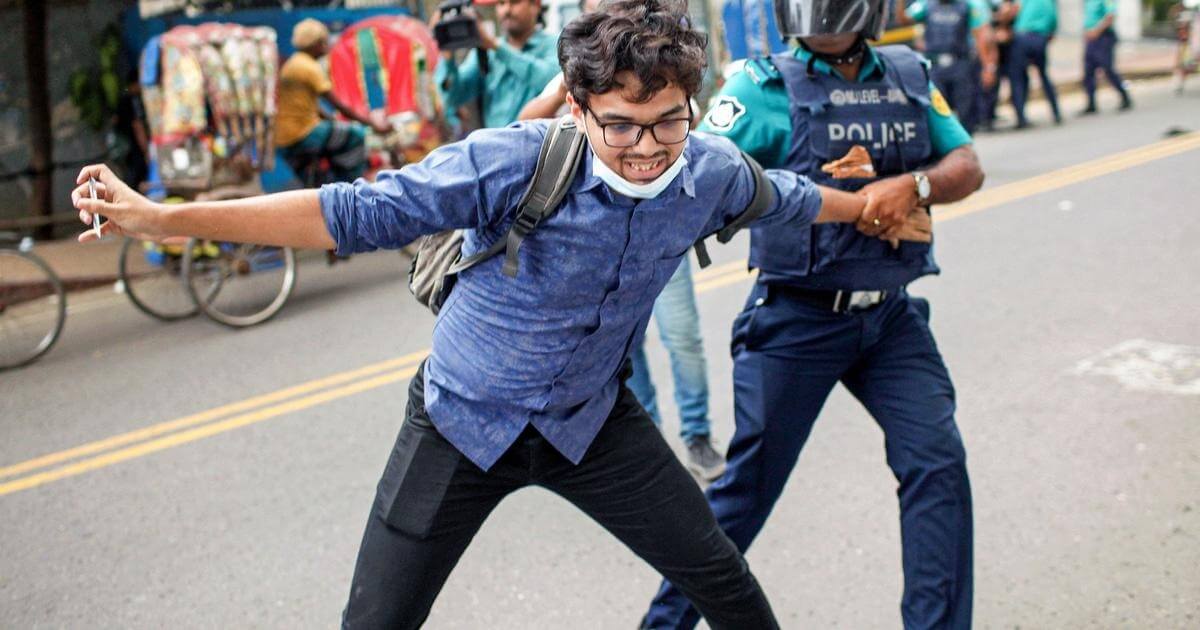What India is Getting Wrong About Bangladesh Student Protests
Sayeed Iftekhar Ahmed | 30 July 2024
There has been a failure to comprehend the genuine grievances of Bangladeshis amid conspiracy theories of China or America undermining security interests.
The response of the Indian government to protests in Bangladesh that have resulted in the deaths of at least 174 people over the past fortnight demonstrates that it has failed to grasp the complexity of the situation.
Alarmed by a decision by the High Court to reinstate the 30% quota in government jobs for the heirs of freedom fighters, students and youth activists took to the streets.
The Bangladesh government underestimated the extent of student discontent, failed to understand the causes of the massive uprising and wrongly attributed the movement to opposition activists, particularly the hardcore Islamist Jamaat-e-Islami’s student wing. Similarly, many in India also failed to grasp the situation.
Apart from a few leftist student organisations and West Bengal Chief Minister Mamata Banerjee, all major political parties, including the ruling ones, have remained silent about the heavy-handed tactics used by the Bangladeshi government to subvert the protests. Their silence may indicate that, rather than seeking to understand the grievances of the Bangladeshi people, they prioritise what they believe is India’s national security, especially if the protests lead to a change of regime.
India’s security concerns
Some Indian media outlets also demonstrated a lack of insight into the true origins of the uprising, as they tended to resort to conspiracy theories that frequently implicated China and, on occasion, the US. Their failure to comprehend the genuine grievances of the masses led them to interpret the situation as either China’s endeavour to thwart a pro-India government for strategic gain or the US’s efforts to undermine India by backing the protests. This simplistic view overlooked the complex dynamics and root causes of the uprising.
Likewise, it was apparent that Indian policymakers struggled to understand the anti-Indian sentiment prevalent among the Bangladesh population, particularly because of New Delhi’s strong ties to the ruling Awami League. Despite unresolved bilateral issues, border killings and trade imbalances, India has demonstrated unwavering support for a government that obstructed fair and inclusive elections.
What is being overlooked?
As the protests bubbled up, Bangladesh Prime Minister Sheikh Hasina made a sarcastic comment, asking who was entitled to job reservations. “If not the grandchildren of the freedom fighters, then who will get quota benefits?” she asked. “The grandchildren of the razakars?”
The term “razakar”, which refers to a member of a “volunteer force”, is historically loaded with negative connotations. In Bangladesh, it refers to those who collaborated with Pakistan during the 1971 war of independence.
Students found this extremely insulting. This sparked massive protests in various institutions, including junior high schools across the nation. Initially, the government decided to treat the entire student community as supporters of hardcore Islamists and the main opposition party, the Bangladesh Nationalist Party. It thought that by doing so, it would legally and morally justify its decision to quell the movement by force.
But the killing of students sparked nationwide anger. Bangladeshis were already furious with the government, mainly due to rampant corruption and embezzlement among government officials and party supporters. Economic mismanagement, inadequate governance, and rising prices of basic necessities exacerbated their frustration.
There is a widespread feeling that the government does not accurately represent the people, particularly because the outcomes of the last three elections did not reflect with the choices of the citizens. This led to a significant legitimacy crisis for the Hasina government.
Furthermore, citizens felt that the Cyber Security Act and other regulatory measures unduly constrained their ability to express their genuine concerns. As a result, the student protests became a platform for people from across the board to voice their frustrations.
What next?
After suppressing the mass protest, authoritarian rulers tend to become more confident and harsher. This trend is evident in Bangladesh as well. Following the successful containment of the movement, Hasina indicated that she will use heavy-handed tactics to suppress her opponents.
The protests did not only reflect the weaknesses of the government. They also highlighted the waning trust in opposition political parties and their associated student organisations. Their inability to effectively mobilise the masses has led to a political vacuum in Bangladesh.
The movement lacks a clearly defined objective: participants expressed a desire to overthrow the government, but the street slogans did not reflect this. This lack of direction is being exploited by government supporters.
It is essential for opposition parties to show a sincere dedication to democracy if future movements are to be successful. A failure to do so could prolong the Hasina regime and provide an opportunity for hardcore Islamists to advance their agenda – which India, not unreasonably, is afraid of.
It is crucial for the Indian government to acknowledge the potential consequences of entrusting the entirety of their security to a single party. Embracing a collaborative approach involving multiple parties within a democratic system will create a more robust security framework.
Democratic nations, after all, are less likely to enter into hostile relationships.
Sayeed Iftekhar Ahmed is a faculty member at the School of Security and Global Studies, American Public University System.
This article was originally published on Scroll In.
Views in this article are author’s own and do not necessarily reflect CGS policy.
